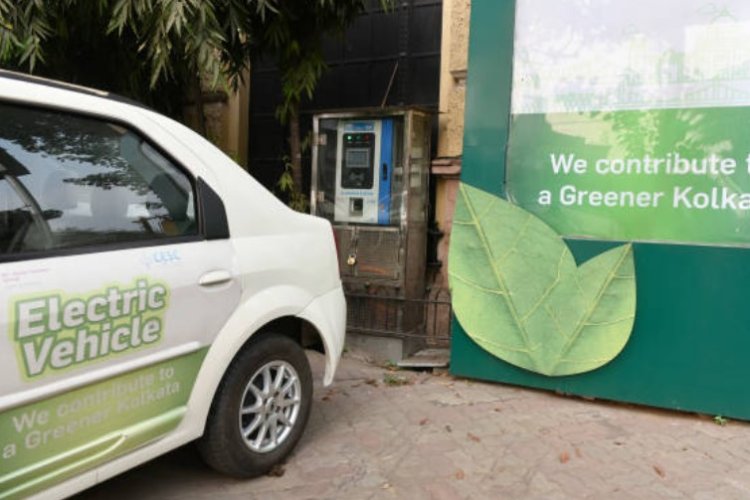
EV adoption in India: India has crossed one million electric vehicle registrations in the first half of FY 26. On its face, this suggests the clean-mobility dream is coming true. But a deeper look reveals emerging cracks. The boom may be less about broad-based demand and more about premium segments and state incentives. If the policy architecture fails to keep pace, the risk is a slowdown that wastes India’s manufacturing thrust and undermines energy-security goals.
According to recent data, India’s electric four-wheeler registrations in Apr-Oct 2025 doubled year-on-year and reached 4.6 % of passenger vehicle share. Meanwhile, total EV registrations in October-2025 hit a new monthly peak of 2.34 lakh units—with two-wheelers still dominant. These numbers show growth. Yet they also hide structural stress.
READ | Blockchain regulation: Why India must see beyond crypto
Much of the surge is concentrated in urban pockets, premium segments and states with strong incentives. At the same time, the price-gap between EVs and internal-combustion engine (ICE) vehicles has narrowed because of GST cuts and import code changes. That reduces the differential advantage and thus the consumer trigger for many buyers. Supply-chain constraints—especially around battery inputs and magnets—remain unresolved.
EV adoption: Why the risk of plateau looms
The transition logic for EVs rests on four pillars: affordability, charging infrastructure, supply-chain stability, and compelling total cost-of-ownership (TCO). If any pillar falters, momentum stalls.
First, affordability remains an issue. Even with subsidies, many EVs cost significantly more upfront than ICE alternatives. Second, charging infrastructure is patchy in many states. Rural and semi-urban areas remain poorly served. Third, supply-chain risks are real: raw-material shortages and import dependencies raise cost risks and hinder mass-market rollout. Fourth, demand is as important as supply. A model driven by premium buyers may reach its ceiling sooner than a model built on mass adoption.
In short, while the one million plus number is promising, it is not yet an inflection point for a full-scale mobility shift. Without deeper structural fixes, India may see growth flatten out rather than accelerate.
Why this matters for India
India has set ambitious targets: 30 % EV sales by 2030, 500 GW non-fossil energy and a large domestic manufacturing ecosystem. If the EV transition stalls, these ambitions are at risk. Manufacturing plants under the Production-Linked Incentive (PLI) scheme may operate below capacity. Job creation will be lower. Imports of petrol and diesel will remain elevated, undermining energy-security and emissions goals.
For households the implications are mixed. Early adopters in urban metros may enjoy lower lifecycle cost. But if subsidies fade, charging remains unreliable and residual values are weak, mid-income buyers may feel apprehensive. For states the risk is stranded infrastructure and subsidies that no longer catalyse demand.
Where the policy gaps are widening
India’s policy architecture has many strengths—FAME-II, state EV policies, PLI for batteries, and tax incentives. Yet gaps persist.
Many state incentives are now being rolled back or capped just when markets are maturing. Some states are seeing adoption stagnate. For example, one report found that a major southern state mustered just 1.8 % EV share in five years. This level of heterogeneity undermines the notion of a uniformly advancing mobility transition.
Infrastructure remains uneven. While metros may boast fast-chargers and network maps, most towns lack reliable public charging. Without this backbone, range-anxiety remains real.
Supply chains are globally contested. India still imports large fractions of cell chemistry, magnets and assembly lines. Without decisive localisation, the manufacturing push remains vulnerable to external shocks and cost escalation. Add to this the fall in GST on ICE vehicles and the narrowing of the differential price advantage for EVs. That undermines the value proposition.
What needs to happen for the transition to regain pace
If India is to turn momentum into mass movement, policy must shift beyond incentives and volume headlines.
First, the focus must move from incentive-driven demand to fundamental affordability and TCO improvement. Lower barrier pricing, credible residual-value frameworks, battery-swapping models, and financing innovations must all come together. Second, charging infrastructure must become as standard as fuel stations. Rural and semi-urban deployment, interoperability across states, and integration with grid-management are critical.
Third, supply-chain resilience must be built—cells, battery manufacturing, magnet recovery, recycling. India cannot afford to import its way to green mobility at scale. Fourth, states must adopt stable, long-term policies rather than short-cycle incentives. A one-year subsidy expansion followed by rollback disrupts investor and buyer confidence.
Equally important is consumer education and transparency. Many buyers remain uncertain about warranty, resale value, charging habits and servicing availability. Without addressing such anxiety, growth may slow.
Momentum is no guarantee of breakthrough
India’s EV numbers are clearly heading in the right direction. The growth in vehicle registration, the manufacturing announcements, the policy framework—all look promising. But what is not yet apparent is the full ecosystem shift: affordability for the many, reliable charging for the accessible, supply chains for the scalable, policy stability for the sustainable.
If India continues on the current trajectory without recalibrating these pillars, the risk is a growth plateau. Instead of a rapid leap to electric mobility, the economy may slip into a prolonged and uneven transition. For a nation with high stakes in climate goals, manufacturing ambition and energy-security, that outcome would be a missed opportunity.
India can still convert momentum into mastery. But only if the next stage of policy is crafted not for those who bought the first wave of EVs, but for those who will buy in the next decade.
